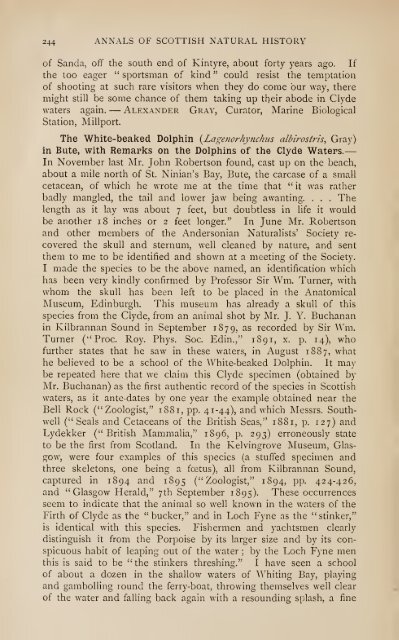You also want an ePaper? Increase the reach of your titles
YUMPU automatically turns print PDFs into web optimized ePapers that Google loves.
244 ANNALS OF SCOTTISH NATURAL HISTORY<br />
of Sanda, off the south end of Kintyre, about forty years ago. If<br />
"<br />
the too eager sportsman of kind " could resist the temptation<br />
of shooting at such rare visitors when they do come our way, there<br />
might still be some chance of them taking up their abode in Clyde<br />
waters again. ALEXANDER GRAY, Curator, Marine Biological<br />
Station,<br />
Millport.<br />
The White-beaked Dolphin (Lagenorhynchus albirostris, Gray)<br />
in Bute, with Remarks on the Dolphins of the Clyde Waters.<br />
In November last Mr. John Robertson found, cast up on the beach,<br />
about a mile north of St. Ninian's Bay, Bute, the carcase of a small<br />
cetacean, of which he wrote me at the time that " it was rather<br />
badly mangled, the tail and lower jaw being awanting. . . The<br />
.<br />
length as it lay was about 7 feet, but doubtless in life it would<br />
be another 18 inches or 2 feet longer." In June Mr. Robertson<br />
and other members of the Andersonian Naturalists' Society recovered<br />
the skull and sternum, well cleaned by nature, and sent<br />
them to me to be identified and shown at a meeting of the Society.<br />
I made the species to be the above named, an identification which<br />
has been very kindly confirmed by Professor Sir Wm. Turner, with<br />
whom the skull has been left to be placed in the Anatomical<br />
Museum, Edinburgh. This museum has already a skull of this<br />
Y. Buchanan<br />
species from the Clyde, from an animal shot by Mr. J.<br />
in Kilbrannan Sound in September 1879, as recorded by Sir Wm.<br />
Turner ("Proc. Roy. Phys. Soc. Edin.," 1891, x. p. 14), who<br />
further states that he saw in these waters, in August 1887, what<br />
he believed to be a school of the White-beaked Dolphin. It may<br />
be repeated here that we claim this Clyde specimen (obtained by<br />
Mr. Buchanan) as the first authentic record of the species in Scottish<br />
waters, as it ante-dates by one year the example obtained near the<br />
Bell Rock ("Zoologist," iSSi, pp. 41-44), and which Messrs. Southwell<br />
("Seals and Cetaceans of the British Seas," 1881, p. 127) and<br />
Lydekker ("British Mammalia," 1896, p. 293) erroneously state<br />
to be the first from <strong>Scotland</strong>. In the Kelvingrove Museum, Glasgow,<br />
were four examples of this species (a stuffed specimen and<br />
three skeletons, one being a fetus),<br />
all from Kilbrannan Sound,<br />
captured in 1894 and 1895 ("Zoologist," 1894, pp. 424-426,<br />
and "Glasgow Herald," 7th September 1895). These occurrences<br />
seem to indicate that the animal so well known in the waters of the<br />
Firth of Clyde as the " bucker," and in Loch Fyne as the "stinker,"<br />
is identical with this species. Fishermen and yachtsmen clearly<br />
distinguish it from the Porpoise by its larger size and by<br />
its conspicuous<br />
habit of leaping out of the water ; by the Loch Fyne men<br />
this is said to be "the stinkers threshing." I have seen a school<br />
of about a dozen in the shallow waters of Whiting Bay, playing<br />
and gambolling round the ferry-boat, throwing themselves well clear<br />
of the water and falling back again with a resounding splash, a fine

















